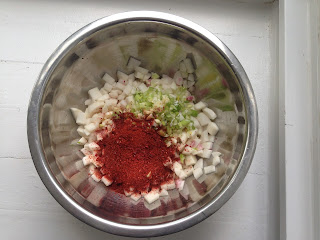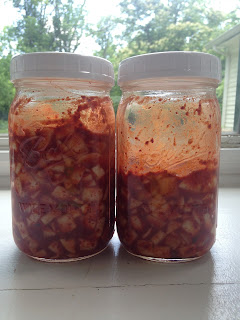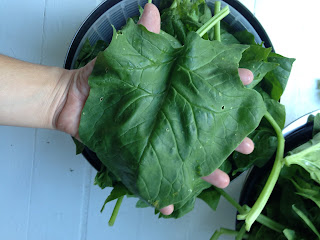This project really excited me and I embraced the process, including a trip to CAM International Market for Korean red pepper flakes (gochugaru). Jonathan and I were both very impressed by the store and he got to pick out two treats.
First, I peeled the daikons, turnips, and spring radishes. Then I cubed them (smaller than Maangchi suggests, like 1/4 to 1/2-inch cubes). I tossed them with sugar and salt and let them sit for half an hour before draining the liquid.
Then I added the magical concoction of red pepper flakes, green onions, ginger, garlic, fish sauce, and a small amount of the radish brine water.
I packed the mixture into quart jars and pressed down so the brine covered the radishes. People have suggestions on how to do this with various tools, but I just used my knuckles. Two words of caution on this process: the red pepper flakes can burn your skin and make it look like you made a horrible mistake with some self-tanner.
I also made kale chips with mixed results.
Kkakdugi (cubed radish kimchi)
Adapted very slightly from here
Ingredients
3 pounds daikon radish, salad turnips, and/or spring radishes, peeled and cut into 1/4-1/2 inch cubes
1 tbsp. salt
2 1/4 tbsp. sugar
1 1/2 tbsp. minced garlic
3/4 tsp. minced ginger
4 green onions/scallions, chopped
3 tbsp. fish sauce
3/8 cup Korean hot pepper flakes (gochugaru) (Notes: If your flakes have more or less sodium than mine I recommend scaling the amount of salt you use accordingly. For example, the salt I used had 590 mg sodium per 1/4 tsp and the flakes had 40.8 mg sodium per 1/4 tsp. Therefore the 3/8 cup flakes had just under 3000 mg sodium. The original salt called for (proportionally to the amount of radish) was 1 1/2 tbsp, which has 10,620 mg sodium. Take 3000 mg out and you end up with 7620 mg sodium needed, which is about 3.25 tsp. I knocked it down to 3 tsp., or 1 tbsp. Hot pepper flakes will also vary in spiciness, but I don't know how to help you there!)
Directions
Combine radishes with salt and sugar and mix well. Set aside for 30 minutes.
Drain the juice from the radish into a bowl.
Add garlic, ginger, green onions, fish sauce, hot pepper flakes, and 1/4 cup juice from the radish.
Mix well until the seasonings coat the radishes evenly.
Put the kkakdugi into a glass jar and press down on the top to remove any air from between the radishes.
Allow to ferment at room temperature (75 F) for two days before storing in the refrigerator. Be sure to push the radishes under the brine after digging in.










No comments:
Post a Comment